Get ready for an exciting trip to Japan. This country is known for blending old traditions with new tech. You’ll find amazing experiences from Tokyo’s bright lights to Kyoto’s peaceful temples. This guide will show you the best places to visit in Japan, top attractions in Japan, and what to do in Japan in 2025.
Japan’s transport system is top-notch, with the famous Shinkansen bullet train. You can easily see the country’s different areas. Japan’s seasons, from cherry blossoms in spring to autumn leaves, offer unique Japan travel guide experiences. Get ready to dive into a mix of old traditions and new tech that will make your trip unforgettable.
Planning Your Trip to Japan: Essential Travel Tips
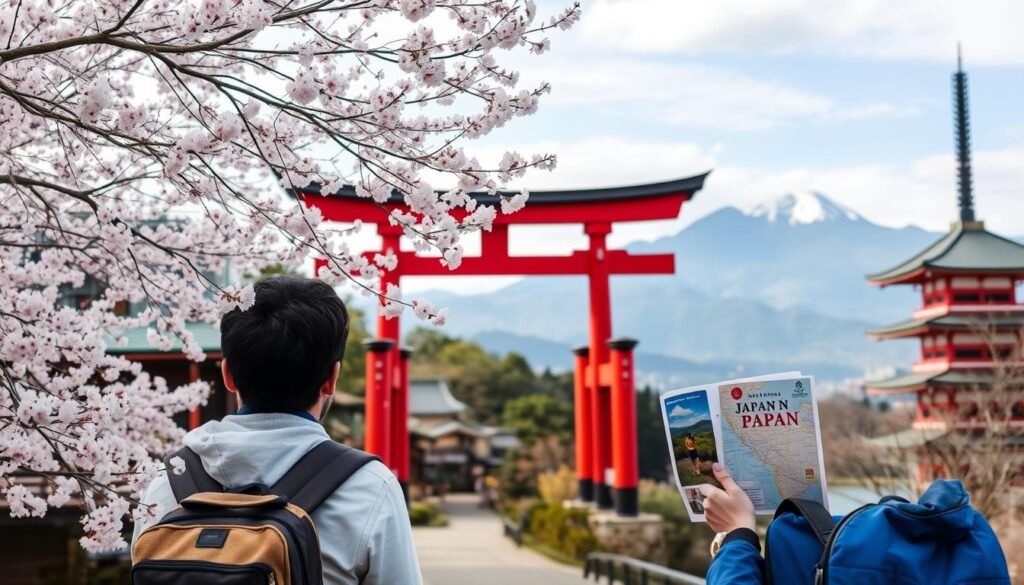
Exploring Japan’s culture and traditions needs careful planning. You’ll want to know the best time to visit, how to budget, and visa needs. Let’s look at the key tips for your Japanese trip.
Best Time to Visit Japan
The best time to visit Japan depends on what you like. Spring (March to May) is great for seeing cherry blossoms. Autumn (September to November) is perfect for fall foliage.
Shoulder seasons like May and late September/early October offer mild weather and fewer crowds.
Budget Planning and Currency
Planning your budget for Japan can vary. A good estimate is $200-$400 AUD per day for a couple in mid-range hotels. Japan mainly uses cash, so carry Japanese yen.
Use 7/11 ATMs for easy withdrawals.
Visa Requirements and Documentation
Most visitors can enter Japan visa-free for up to 90 days, based on their nationality. But, always check your country’s specific visa needs. Also, make sure your passport is valid for at least six months and has blank visa pages.
With these travel tips, you’re ready for an amazing journey through Japan’s culture and traditions. And, you’ll have a well-planned itinerary for Japan.
Getting Around Japan: Transportation Guide
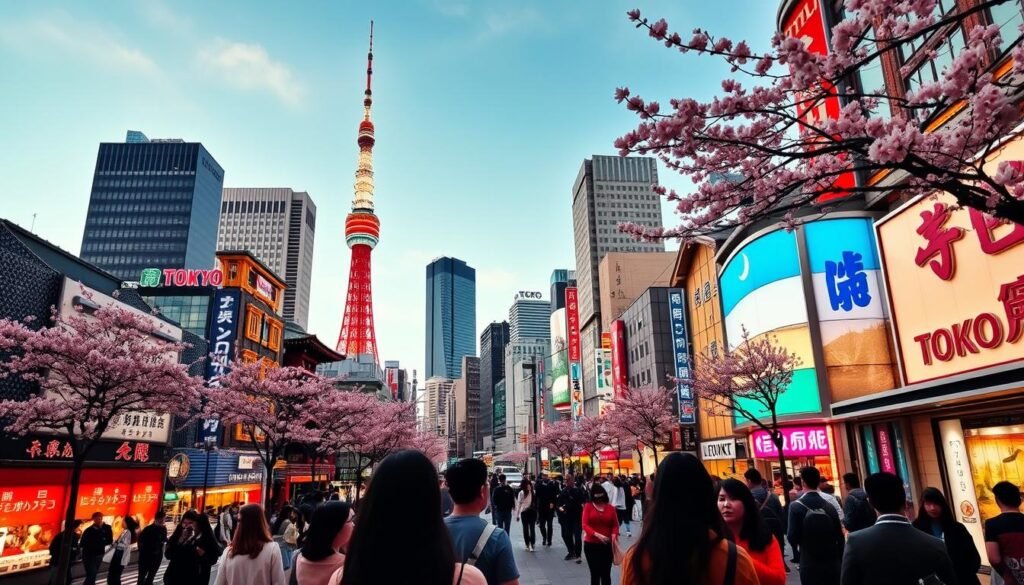
Traveling around Japan is easy thanks to its great public transport. The Suica or Pasmo card is perfect for moving around on subways, trains, and buses. It makes getting around simple.
The Shinkansen bullet trains are great for long trips. They can go up to 320 km/h. This means you can quickly travel between cities like Tokyo and Osaka. But, with recent price hikes, many now choose individual tickets over the Japan Rail Pass.
In cities like Tokyo and Osaka, the subway is key. But in places like Kyoto and Kanazawa, buses are better for seeing the sights.
Exploring Tokyo or planning an itinerary in Japan is easy with Japan’s transport. A bit of planning and local tips will have you moving around like a pro.
What To Do In Japan: Top Attractions and Activities
Japan is a place where old traditions meet new wonders. You can dive into the Japanese culture and traditions or see the top attractions in japan. There’s so much to explore.
Traditional Cultural Experiences
Experience Japan’s heritage by attending a traditional tea ceremony or watching a sumo wrestling match. You can also walk through Kyoto’s historic streets in a rented kimono. See the beautiful Itchiku Kubota kimonos, which use a 16th-century dyeing technique.
Modern Japanese Entertainment
For a modern culture fix, go to Akihabara in Tokyo. It’s full of anime, manga, and gaming. Try themed cafes, sing karaoke, and see the latest technology.
Natural Landmarks and Scenic Spots
Japan’s natural beauty is amazing, from Mount Fuji to the Japanese Alps. Don’t miss the Shibuya Crossing in Tokyo, the Fushimi Inari Shrine in Kyoto, and the Peace Memorial in Hiroshima.
| Activity | Description | Cost |
|---|---|---|
| Stay in a Ryokan | Experience traditional Japanese inn accommodations, often including meals. | Varies from simple to ultra-luxurious |
| Onsen Visit | Enjoy the therapeutic benefits of natural hot spring baths, with both indoor and outdoor options. | Typically free or low-cost |
| Kimono Rental | Dress up in the traditional Japanese garment and explore historic neighborhoods. | Around 3,000-5,000 Yen |
| Sumo Wrestling Match | Witness the rituals and traditions of this iconic Japanese sport. | Varies by tournament |
| Kabuki Performance | Experience the elaborate costumes and makeup of this traditional Japanese theater. | Typically 3,000-10,000 Yen |
Japan has both timeless traditions and modern wonders. It offers unforgettable experiences for all travelers. Explore the top attractions in japan and japanese culture and traditions for a memorable trip.
Seasonal Highlights and Festivals Throughout 2025
Japan is a year-round wonder, filled with festivals and seasonal highlights. These offer unique cultural experiences for travelers. From the winter wonderlands of the north to the vibrant summer celebrations, there’s always something captivating to discover.
In January and February, the Sapporo Snow Festival in northern Japan is a must-see. It features awe-inspiring ice sculptures the size of buildings. Tokyo’s average temperatures in these months are around 6-7°C, with rare drops below freezing. Visitors can also explore the winter peony garden at Ueno Toshogu Shrine in Tokyo, showcasing 160 peony plants of 40 different varieties.
As February arrives, the Setsubun festival takes center stage. Events are held at shrines like Suitengu Shrine and Teppozu Inari Shrine. This marks the seasonal turning point and chases away evil spirits. It’s a unique chance for travelers to dive into japan travel guide traditions.
The arrival of spring brings the cherry blossom viewing season, or Hanami, to cities across Japan. The Hirosaki Cherry Blossom Festival in Aomori is a highlight, featuring over 2,600 cherry blossom trees, some over 300 years old.
As the weather warms, summer brings festivals and events. The Sumida River Fireworks Festival in Tokyo, the Shinagawa Yakimo Terrace gourmet event, and the Aomori Nebuta Festival are highlights. The Nebuta Festival attracts over 3 million guests with its huge 3D papier mache floats.
In autumn, the Mito Plum Blossom Festival in Ibaraki and the Oedo Beer Festival Autumn and Tokyo Ramen Festa offer local and international flavors. The Whiskey Festival caters to spirit enthusiasts.
Throughout the year, Tokyo hosts a wide range of events. These include the Hatsumode at Sensoji Temple, Meiji Shrine Spring Festival, Anime Japan, Tokyo Game Show, and the popular Tokyo Christmas Market. These provide endless opportunities for what to do in japan.
| Season | Festivals and Events |
|---|---|
| Winter |
|
| Spring |
|
| Summer |
|
| Autumn |
|
| Year-Round |
|
Japan offers an abundance of cultural experiences and festivities all year round. Travelers can immerse themselves in these and create lasting memories.
Must-Visit Cities and Regions
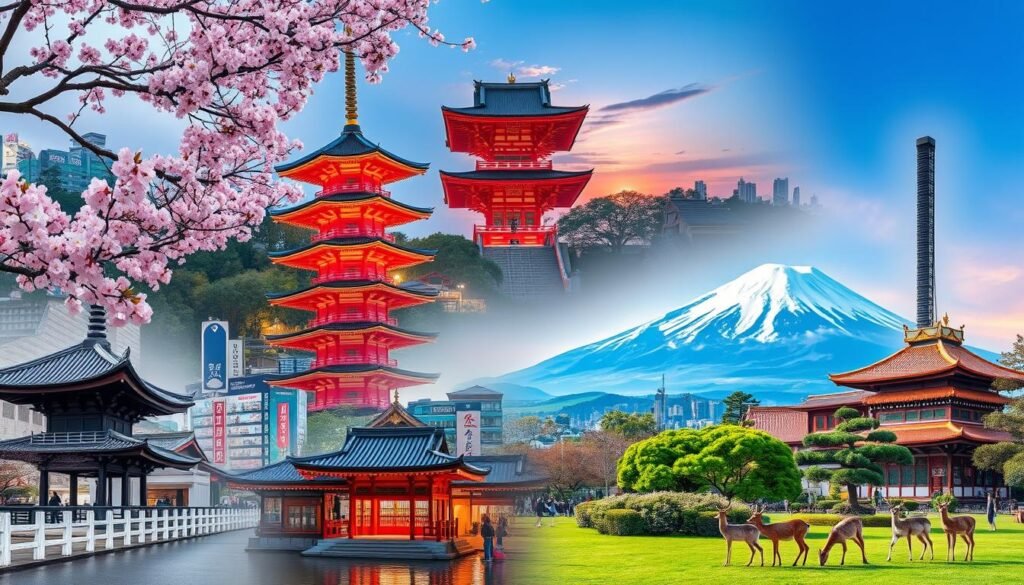
Japan is a land of diverse landscapes, rich culture, and exciting experiences. Make sure to visit these cities and regions to see the best of Japan.
Tokyo and Surrounding Areas
Tokyo, the capital, is a mix of modern and traditional. Visit the Senso-ji Temple for peace, see the Tokyo Skytree for views, and explore Shibuya and Shinjuku for fun. Don’t miss Kamakura, Yokohama, and Mount Nokogiri for day trips.
Kyoto’s Cultural Heritage
Kyoto, the old capital, is famous for its culture. Spend at least 3 nights, but 5 is better to see all the temples, shrines, and gardens. Visit Fushimi Inari Shrine, Kibune Village, and Kurama-dera Temple. Explore Gion, Higashiyama, and Arashiyama for Kyoto’s beauty.
Hidden Gems Off the Beaten Path
Japan has many hidden gems beyond famous spots. Check out Takayama for its old town, Nozawa Onsen for skiing and hot springs, and the Fuji Five Lakes for Mount Fuji views. Hokkaido, Tohoku, Chubu, Chugoku, Shikoku, and Kyushu offer natural beauty, culture, and unique experiences.
| Destination | Recommended Stay | Top Attractions |
|---|---|---|
| Tokyo | 3-5 nights or longer for day trips | Senso-ji Temple, Memory Lane in Shinjuku, Shibuya Crossing, Takeshita Street in Harajuku, TeamLab Planets |
| Kyoto | 3 nights minimum, but 5 nights better | Fushimi Inari Shrine, Kibune Village, Kurama-dera Temple, Gion, Higashiyama, Arashiyama |
| Takayama | 2-3 nights | Old Town, Morning Markets, Hida Folk Village, Countryside Cycling |
| Hakone | Not provided | Lake Ashi for views of Mount Fuji, Hakone Loop with different modes of transport, Owakudani Volcanic Area |
Japanese Cuisine and Food Experiences
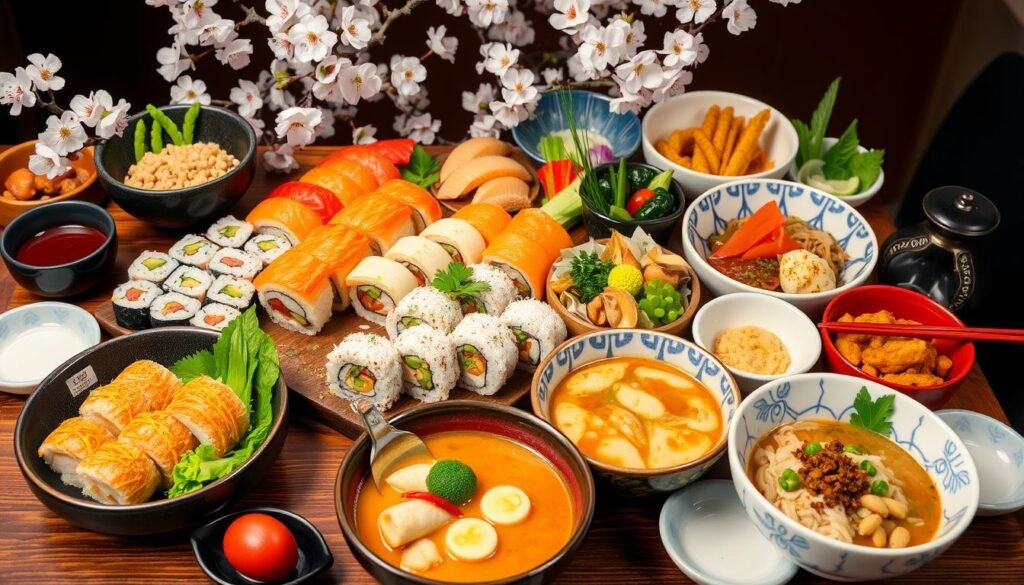
Discover the exciting world of Japanese cuisine on your travels. You’ll find everything from famous ramen to beautiful sushi. Try traditional dishes like tempura, okonomiyaki, and kaiseki cuisine to see Japan’s cooking skills.
Looking for something affordable? Try conveyor belt sushi restaurants or izakayas (Japanese pubs). They offer a variety of small dishes and local favorites. You can also enjoy making your own okonomiyaki or sukiyaki hot pot.
Make sure to take a food tour in cities like Tokyo, Osaka, and Kyoto. These tours are a great way to learn about Japan’s food culture. You’ll visit places like Tsukiji Fish Market and Nishiki Market. You’ll learn about traditions, ingredients, and cooking methods that make Japanese food special.
Japan has something for everyone, from rich ramen to artistic sushi and cozy hotpots. The Japanese cuisine will amaze you and leave a memorable taste. Dive into Japan’s food culture and enjoy every bite.
Accommodation Options Across Japan
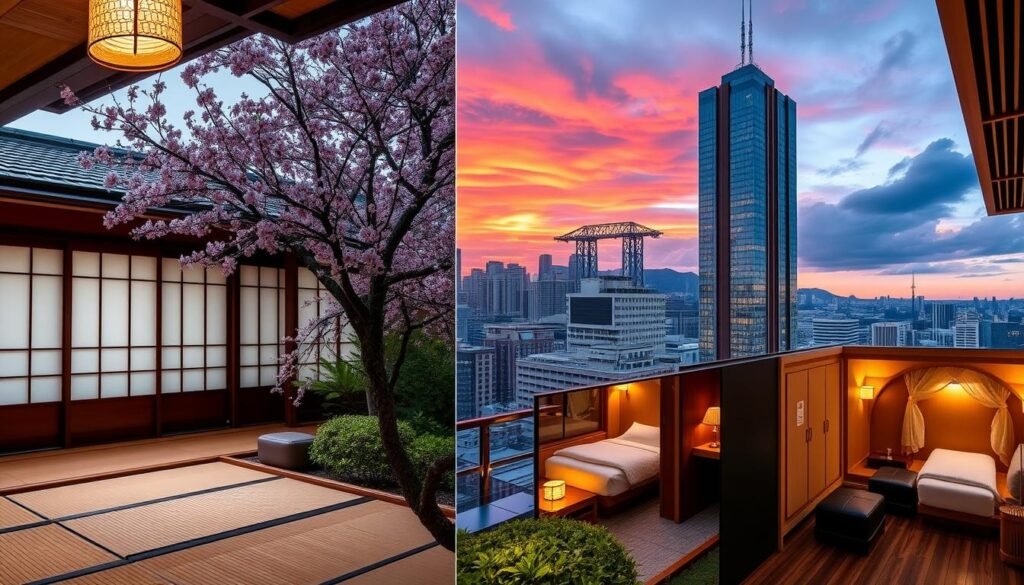
When planning your itineraries for japan, think about the many places to stay. You can choose from traditional ryokans, modern hotels, or budget-friendly options. Japan has something for everyone, no matter your budget or preferences.
Traditional Ryokans
Stay in a ryokan for a true taste of Japanese culture. These inns offer tatami-matted rooms, hot spring baths, and delicious meals. While they might cost more, the experience is unique and memorable.
Modern Hotels and Budget Stays
Looking for something more affordable? Japan’s cities have many modern hotels and business hotels. Brands like APA Hotel offer clean rooms at good prices, starting around 8,000-20,000 yen ($54-134) per night. These places have Wi-Fi, air conditioning, and are in great locations.
Unique Lodging Experiences
- Capsule hotels: Try the futuristic, compact rooms found in Tokyo and Osaka. Prices are from 2,000 to 7,000 yen ($16-58) per night.
- Temple stays: Live in a shukubo, a temple lodging, to learn about Japanese Buddhism. You’ll enjoy meditation, morning prayers, and more.
- House and apartment rentals: Rent a place through Airbnb for a flexible stay. Prices vary, but you can find deals in cities like Tokyo and Kyoto for $94 to $154 per night.
Book your stay in japan early, as prices go up during peak seasons like spring and Golden Week. Use sites like Booking.com or Japanican to find your ideal place to stay.
Cultural Etiquette and Local Customs
Diving into Japanese culture and traditions is key when visiting Japan. From the start, you’ll see many unique customs and etiquette in daily life. Knowing these customs helps you respect the culture and fit in well.
Removing shoes before entering homes, ryokans, and some restaurants is common. This is called genkan and keeps places clean and sacred. You’ll find a shoe area at the door where you can change into slippers.
Bowing is a big part of Japanese culture and traditions. It shows respect and can mean different things based on the bow’s depth and length. Learning basic bowing can show you care about the culture.
| Cultural Etiquette Aspect | Explanation |
|---|---|
| Body Contact | Japanese people usually don’t touch much in everyday life. So, it’s best to avoid touching or patting others. |
| Dining Phrases | Learn phrases like “Itadakimasu” (before eating) and “Gochisosama-deshita” (after eating). |
| Train Etiquette | Don’t talk loudly on phones on trains and buses. Also, give priority seats to the elderly, pregnant, or disabled. |
| Sushi Etiquette | Eat sushi with chopsticks or hands, not by dipping rice in soy sauce. |
By embracing these Japanese culture and traditions, you’ll improve your trip and show respect for Japan. A bit of cultural knowledge can make your visit memorable and meaningful.
Conclusion
Japan is a place where old traditions meet new ideas. You can find bustling streets and peaceful temples here. It’s a country that has something for everyone.
When planning your trip, think about the seasons and local foods. This will help you enjoy Japan even more. From busy cities to quiet temples, Japan is full of surprises.
Japan’s culture is unique and its food is amazing. You can find famous spots and hidden treasures. Japan’s easy to get around and has many places to stay.
Whether you love culture, city life, or nature, Japan has it all. It’s a place that will make you want to come back. Japan is a country that will inspire you to explore more.

